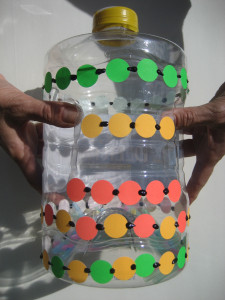We’re proud to be part of the Middle Eastern North Africa blog hop. Naturally our post is about music, but make sure you check out all the other related posts (listed below) to learn more about this beautiful and culturally rich part of the world.
Crafting is a great hands-on way for kids to learn about world cultures, so our post shows you how to make a sistrum, a unique rattle that was used in the courts of the Pharoahs of ancient Egypt.
What is a Sistrum?
You can see images of sistrums in hieroglyphics found in the pyramids. A bit of study of the courts of the Pharoahs reveals that the sistrum was played mainly by women or priestesses and that it was played by moving it back and forth from side to side so that the metal bangles create a unique sound and distinctive rhythms. It was often part of ceremonial or the sacred/religious music of the time.
 Make Your Own Sistrum From a Tree Branch
Make Your Own Sistrum From a Tree Branch
If you take a walk in a wooded area, it’s easy to find a tree branch that is shaped like the letter “Y”. You can use the branch “as is” or cut and sand it down, if you like.
Next, you’ll need a bit of floral wire or craft wire. Wrap it around one side of the Y, then add whatever bangles you may have. Below we have a post showing how to safely make bangles from bottlecaps, which is a fun recycling project. Instead – or in addition to bangles – you can also use things like beads,  jingle bells or bits of jewelry to add to the bling of your sistrum. Be as creative as you like!
jingle bells or bits of jewelry to add to the bling of your sistrum. Be as creative as you like!
Playing A Sistrum
Although the traditional way to play a sistrum is to move it back and forth only, it’s a rattle so feel free to use it as a percussion instrument any way you like.
Links and Resources
Free Egyptian Sistrum Coloring Page- https://www.teacherspayteachers.com/Product/Color-An-Ancient-Egyptian-Rattle-The-Sistrum-2166721
Make Your Own Bangles From Bottlecaps Post – http://www.tinytappingtoes.com/ecologynature/how-to-make-bottle-cap-bangles-for-recycled-musical-instruments/

Welcome to the third annual Middle Eastern and North African Heritage Month series from Multicultural Kid Blogs! Follow along all month long for great resources on teaching children about the heritage of this region, and link up your own posts below. Don’t miss our series from last year and from 2015!
You can also find even more resources on our North Africa and the Middle East Pinterest board:
Link Up Your Posts!






































